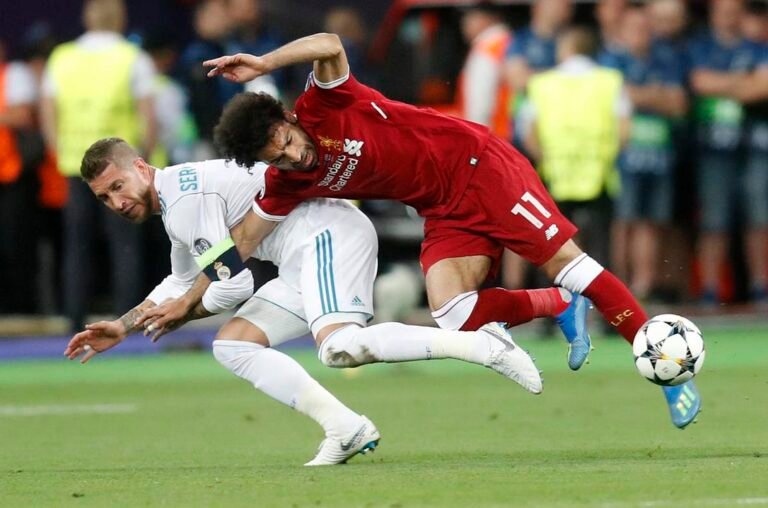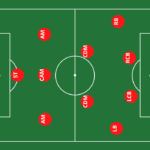- Last Updated -
The Growing Concern for Player Safety in Soccer
Concussion Substitutions in Soccer
The physical nature of the game, with its high-speed collisions, aerial challenges, and competitive tackles, puts players at risk of sustaining various injuries.
Among these concerns, concussions have emerged as a significant issue that cannot be taken lightly. Concussions, often resulting from head clashes or blows to the head during matches, are traumatic brain injuries that can have serious long-term consequences if not managed properly.
The potential risks associated with concussions range from cognitive impairment to an increased likelihood of developing neurodegenerative diseases later in life.
With heightened awareness and an increasing body of research highlighting the long-term impact on players’ health and well-being, soccer’s governing bodies are under pressure to prioritize player safety.
The Need for Effective Concussion Management Protocols
Given the potential severity of concussions and their long-lasting effects on athletes’ lives beyond their playing careers, effective concussion management protocols must be established in soccer. Prompt recognition and proper management are vital to prevent further harm and promote optimal recovery for affected players.
However, identifying concussions during matches can be challenging due to several factors. The fast-paced nature of soccer often makes it difficult for medical staff or officials to notice subtle signs indicating possible head injuries.
Additionally, players may downplay or hide symptoms due to their desire to continue contributing to their team’s success or fearing negative repercussions such as being substituted out of an important match.
Therefore, a comprehensive approach is needed—an integration of reliable assessment tools that allow quick evaluation on the field coupled with clear guidelines on how suspected concussed players should be managed moving forward.
The Introduction of Concussion Substitutes as a Potential Solution
To address the growing concern for player safety and improve concussion management, soccer’s governing bodies have introduced the concept of concussion substitutes.
This innovative proposition aims to provide a viable solution that allows teams to temporarily substitute players suspected of having concussions, thereby facilitating proper examination and treatment without compromising the competitive nature of the game.
Currently, soccer’s substitution rules only permit a limited number of substitutions during a match for tactical or injury-related reasons. However, this rule change proposal suggests allowing additional substitutions exclusively for suspected concussed players.
By doing so, teams can ensure that their athletes receive immediate medical assessment while minimizing potential risks associated with playing on with a head injury. The introduction of concussion substitutes has sparked debates among fans, players, coaches, and medical professionals regarding its feasibility and effectiveness.
Pilot programs and trials have been conducted at various levels of the game to assess the practicality and impact these substitutions may have on player safety. As we delve deeper into understanding concussions in soccer and how this proposed rule change addresses the need for better management protocols, it becomes clear that balancing player safety and maintaining competitive integrity is paramount.
In the following sections, we will explore the evolution of concussion protocols in soccer history as well as examine case studies from leagues that have adopted this rule change.
We will closely evaluate both benefits and potential drawbacks before coming to any conclusive opinions on whether concussion substitutes are indeed an effective solution in protecting athletes’ well-being within the beautiful game.

Understanding concussions in soccer
Definition and causes of concussions
When it comes to understanding the nature of concussions in soccer, it is crucial to first establish a clear definition. A concussion is a mild traumatic brain injury that occurs when a player sustains a blow to the head or body, causing the brain to move rapidly back and forth within the skull.
This sudden movement can disrupt normal brain functioning and result in various symptoms such as headaches, dizziness, confusion, and memory problems. The causes of concussions in soccer are diverse and can be attributed to both player-player contact and player-surface contact.
Head-to-head collisions, unintentional clashes with elbows or knees during aerial challenges, or even accidental falls onto hard turf surfaces can all lead to concussive injuries. Additionally, intentional fouls such as elbow strikes or reckless tackles also pose a significant risk for concussions.
Prevalence and Impact on Players’ Health
The prevalence of concussions in soccer has gained considerable attention over recent years due to heightened efforts toward player safety awareness. Studies have indicated that these head injuries are more common than previously thought.
According to an analysis conducted by FIFA’s Medical Assessment and Research Centre (F-MARC), approximately 10% of all football injuries involve some degree of concussion. The impact of concussions on players’ health should not be underestimated.
Immediate consequences may include cognitive impairments (such as difficulties with concentration or memory), physical symptoms (like headaches or nausea), emotional disturbances (such as anxiety or depression), and sleep disturbances.
Moreover, there is growing concern regarding potential long-term effects such as chronic traumatic encephalopathy (CTE) – a degenerative brain disease linked to repeated blows to the head – which has been observed in retired professional footballers.
Challenges in identifying and managing concussions during matches
Identifying and managing concussions during soccer matches pose significant challenges due to several factors.
Firstly, the nature of the sport often involves fast-paced action and split-second decision-making, making it difficult for referees, coaches, and medical staff to immediately recognize potential head injuries in the chaos of the game. Furthermore, players themselves may downplay or hide symptoms to avoid being substituted or to maintain their competitive edge.
The absence of obvious external signs further complicates identification. Unlike visible injuries such as fractures or sprains, concussions are internal injuries that cannot be easily detected without proper assessment tools.
Consequently, relying solely on subjective self-reporting by players may not be sufficient in ensuring accurate diagnosis on the field. Additionally, limited access to immediate medical evaluations during matches adds another layer of complexity in effectively managing concussions in real-time scenarios.
Understanding concussions in soccer involves defining what they are and how they occur within the game’s context. The prevalence of these head injuries raises concerns about their impact on players’ short- and long-term health.
Overcoming challenges in identifying and managing concussions during matches requires improved recognition methods that go beyond self-reporting while considering the fast-paced nature of soccer. Only by comprehensively addressing these aspects can we work towards creating safer playing environments for athletes at all levels.

Evolution of Concussion Protocols in Soccer
Historical Perspective: Early Recognition and Management of Head Injuries
Soccer, being a physically demanding sport, has long been associated with head injuries. However, the recognition and management of concussions in soccer have evolved significantly over the years. In earlier times, head injuries were often overlooked or downplayed due to a limited understanding of their potential long-term effects.
Players who sustained blows to the head would often be encouraged to continue playing without proper assessment or medical intervention. As medical knowledge advanced and concerns regarding player safety escalated, organizations began acknowledging the significance of head injuries and their potential implications.
Various incidents involving high-profile players experiencing severe consequences from untreated concussions played a crucial role in raising public awareness. These incidents served as catalysts for change within the soccer community, prompting governing bodies like FIFA to take proactive steps toward improving concussion protocols.
FIFA’s Role in Shaping Concussion Guidelines and Policies
FIFA, as the international governing body for soccer, holds great influence over the development and implementation of concussion guidelines and policies worldwide.
Understanding its responsibility to prioritize player welfare, FIFA has actively engaged with experts and conducted extensive research to establish comprehensive protocols that address concussions effectively. One significant milestone in FIFA’s commitment to concussion management was the establishment of “The Zurich Consensus” in 2008.
This consensus brought together leading experts from various fields related to head injuries and resulted in groundbreaking guidelines for recognizing and managing concussions in soccer. The Zurich Consensus provided a standardized approach that emphasized player safety while considering the unique dynamics of the game.
The Zurich Consensus: A Milestone in Concussion Management
The Zurich Consensus represented a shift from previous practices by emphasizing early recognition, appropriate evaluation processes, removal from play when necessary, and gradual return-to-play measures following a concussion.
It outlined a step-by-step approach to diagnosing concussions, ensuring players received adequate medical attention, and allowing ample recovery time before returning to the field.
Furthermore, the Zurich Consensus provided guidelines for healthcare professionals and coaches involved in player management, stressing the importance of ongoing education and awareness.
This landmark agreement recognized that concussion management extends beyond immediate on-field evaluations; it extended to post-injury monitoring and a gradual return-to-play protocol.
Continuous Updates to Address Emerging Research Findings
Concussion research is an ever-evolving field, with new insights and discoveries emerging on an ongoing basis. Recognizing this fact, FIFA has remained committed to regularly updating its concussion guidelines based on the latest scientific evidence. These updates ensure that protocols remain aligned with current best practices and reflect the growing understanding of concussions’ long-term effects.
FIFA’s proactive approach to incorporating emerging research findings into its guidelines demonstrates its dedication to player welfare. By staying at the forefront of concussion management advancements, FIFA aims to protect players from unnecessary risks while enabling them to continue participating in the beautiful game they love.
Through historical developments, FIFA’s involvement in shaping concussion policies, significant milestones like The Zurich Consensus, and continuous updates informed by scientific progress, soccer has taken great strides in improving concussion recognition and management protocols.
These efforts have not only enhanced player safety but also underscored soccer’s commitment to prioritizing the well-being of those who participate in this globally beloved sport.

The Concept of Concussion Substitutes
An Innovative Approach Towards Player Safety
In response to the growing concern for player safety in soccer, the concept of concussion substitutes has emerged as a potential solution. This innovative approach aims to address the challenges related to identifying and managing concussions during matches.
The substitution rule change proposal allows temporary substitutions for suspected concussed players, ensuring their well-being while maintaining fair play and preventing any misuse or strategic advantage. The primary objective behind implementing concussion substitutes is to prioritize player safety above all else.
By allowing temporary substitutions for suspected concussed players, teams can provide immediate medical attention and properly assess the severity of head injuries without compromising the integrity of the game. This rule change acknowledges that head injuries require special attention and cannot be overlooked in the pursuit of victory.
Ensuring Fair Play: Limiting Substitutions
To maintain fairness in soccer matches while implementing concussion substitutes, it is crucial to limit the number of substitutions allowed. This limitation helps prevent teams from abusing the rule change by constantly substituting players under false pretenses or seeking strategic advantages unrelated to player safety.
By setting a reasonable cap on substitutions, teams are encouraged to make informed decisions about which players genuinely require medical assessment for potential concussions. Additionally, limiting substitutions helps mitigate concerns over disrupting game flow excessively.
Soccer is known for its fluidity and rhythm, and too many interruptions can hinder both teams’ abilities to maintain momentum and engage in a dynamic contest. Striking a balance between player safety and maintaining competitive integrity is essential when introducing new rules like concussion substitutes.
Time Restrictions: Preventing Misuse or Strategic Advantage
To further prevent misuse or strategic advantage through excessive substitution practices under the guise of possible concussions, time restrictions should be imposed on concussion substitutes. These time limitations ensure that temporary replacements are not used as an opportunity to intentionally delay the game or gain undue advantage.
Implementing strict guidelines on the duration of concussion substitutions helps maintain the integrity and flow of matches while safeguarding players’ health.
By imposing time restrictions, teams are motivated to promptly assess suspected concussed players and make informed decisions regarding their participation in the match. This approach strikes a balance between allowing sufficient time for medical evaluation and minimizing any potential manipulation of the substitution rule for tactical purposes.
Introducing concussion substitutes in soccer is an innovative approach that prioritizes player safety without compromising fair play. By temporarily substituting suspected concussed players, teams can provide necessary medical attention while maintaining competitive integrity.
Establishing limits on substitutions and imposing time restrictions ensures that this rule change is used appropriately, preventing misuse or strategic advantage. The concept of concussion substitutes represents a significant step towards improving concussion management protocols in soccer and protecting the well-being of athletes on the field.

Pilot Programs and Trials
Implementing Concussion Substitutes at Various Levels
In order to assess the viability and effectiveness of the introduction of concussion substitutes in soccer, pilot programs and trials have been conducted at various levels of play, ranging from youth leagues to professional competitions.
This multi-tiered approach allows for a comprehensive understanding of how the rule change impacts different age groups and skill levels.
At the youth level, where player safety is paramount, several governing bodies have embraced the concept of concussion substitutes. For instance, in some youth leagues, such as those organized by U.S. Youth Soccer or England’s Football Association (FA), protocols have been implemented to enable temporary substitutions for players suspected of suffering a concussion.
These initiatives aim to provide young athletes with immediate access to appropriate medical attention while minimizing potential risks associated with continuing play. Meanwhile, professional leagues like the English Premier League (EPL) have also recognized the importance of proactive concussion management.
In January 2021, following successful trials during the 2020-2021 season, the EPL officially adopted a rule allowing up to two additional substitutions specifically for suspected concussions. This decision was influenced by case studies and extensive data analysis conducted throughout the trial period.
Examination of Effectiveness and Challenges Faced During Trials
During these pilot programs and trials, researchers closely monitored how well concussion substitutes functioned in practice. The primary objective was to evaluate their effectiveness in safeguarding player welfare while ensuring fair competition.
Case studies from leagues that have already embraced this rule change offer valuable insights into its implementation challenges. For example, within the English Premier League, match officials noted that identifying potential concussions during fast-paced games was not always straightforward due to subjective symptoms such as dizziness or disorientation.
Therefore, proper training for medical personnel became crucial in distinguishing between concussions and less severe head injuries. Additionally, the trials revealed that time management was a significant aspect to consider.
To prevent teams from exploiting the rule for tactical advantages, strict time restrictions were put in place for concussion substitutions. Ensuring that these replacements occurred efficiently without disrupting game flow required clear protocols and effective communication between referees, medical staff, and coaching teams.
Ultimately, the trials provided valuable data regarding the overall success of implementing concussion substitutes in soccer. The findings not only shed light on the effectiveness of this rule change but also emphasized the importance of ongoing evaluation and refinement to address any challenges encountered during implementation.

Benefits and Potential Drawbacks
Enhanced Player Safety through Improved Identification and Management of Concussions
Concussion substitutes in soccer have the potential to significantly enhance player safety by improving the identification and management of concussions. With this rule change, teams will be able to replace players suspected of having a concussion temporarily, allowing them to undergo thorough medical assessments without the pressure to continue playing.
This means that players who may have suffered a head injury can be promptly evaluated by medical professionals before making any decisions regarding their return to play.
By providing an opportunity for comprehensive assessment, concussion substitutes enable medical staff to conduct more extensive evaluations, such as neurocognitive testing and imaging scans if necessary. This enhanced diagnostic process ensures that concussions are not overlooked or misdiagnosed, reducing the risk of long-term health consequences for players.
Additionally, it allows for immediate removal from play if a concussion is confirmed, preventing further injury or complications that could arise from continued participation. Furthermore, the introduction of concussion substitutes encourages greater collaboration between team physicians, independent medical experts, and match officials.
The collective responsibility for player welfare becomes more pronounced as these stakeholders work together closely during matches. This collaborative approach not only aids in accurate diagnosis but also promotes a culture of prioritizing player safety above all else.
Reduced Pressure on Players to Continue Playing Despite Potential Head Injuries
A major benefit of implementing concussion substitutes is the alleviation of pressure on players to continue participating despite potential head injuries.
In competitive sports like soccer, athletes often face immense scrutiny and expectations from their teams and fans alike. Consequently, there can be considerable pressure on players to downplay or ignore symptoms in order to remain on the field.
With the introduction of temporary substitutions for suspected concussions, players no longer need to make difficult decisions about their health in high-pressure situations. They can confidently step out of the game, knowing that their well-being takes precedence over the match’s outcome.
This shift in mentality ensures that players prioritize their long-term health and mitigates the potential risks associated with playing through undiagnosed concussions. Moreover, reducing the pressure on players to continue playing despite head injuries fosters a healthier sports culture.
It sends a strong message that player welfare is paramount and encourages athletes to take ownership of their well-being. By promoting a climate where players feel empowered to prioritize their health, we create an environment that values the long-term development and safety of athletes.
Maintaining Competitive Integrity while Allowing Necessary Medical Interventions
The introduction of concussion substitutes aims to strike a delicate balance between ensuring player safety and maintaining competitive integrity. Critics may argue that temporary substitutions disrupt the flow of the game or allow teams to exploit tactical advantages. However, careful implementation can address these concerns while still addressing urgent medical needs.
To maintain competitive integrity, rules can be established to limit the number of concussion substitutions allowed per team during a match. By placing reasonable restrictions on these substitutions, it minimizes potential abuse or strategic manipulation by teams seeking an advantage on the field.
Additionally, time limitations can be enforced for medical assessments during temporary substitutions to prevent unnecessary delays or misuse. Striking this balance requires ongoing monitoring and evaluation by regulatory bodies like FIFA in collaboration with medical experts.
Close scrutiny ensures that necessary medical interventions are incorporated seamlessly into matches without compromising fair play or turning them into fragmented events. By thoughtfully considering both benefits and potential drawbacks, it becomes clear that introducing concussion substitutes in soccer has immense value for enhancing player safety and fostering a culture of prioritizing athlete welfare.
Criticisms and Concerns Surrounding Concussion Substitutes
Potential Disruption to Game Flow Due to Frequent Substitutions
One of the primary concerns raised by critics of concussion substitutes in soccer is the potential disruption to the flow of the game caused by frequent substitutions.
Soccer is known for its fluidity and continuous play, and introducing additional substitutions could lead to more stoppages and breaks in rhythm. Critics argue that this may negatively impact the overall viewing experience for fans and affect the strategic dynamics of matches.
Moreover, opponents of concussion substitutes fear that teams may exploit this rule change by tactically substituting players under the guise of a suspected concussion, thus manipulating game situations to their advantage. To address these concerns, it is crucial for governing bodies such as FIFA to establish clear guidelines regarding the use of concussion substitutes.
Strict protocols should be put in place to ensure that medical staff’s assessments are objective, transparent, and conducted within a prescribed time frame. Additionally, limits on the number or timing of substitutions can be implemented to strike a balance between player safety and minimizing disruption to game flow.
Risk of Exploiting the Rule Change
Another apprehension surrounding concussion substitutes is related to the potential exploitation of this rule change by teams seeking an unfair advantage. Critics argue that players might fake or exaggerate symptoms to force a substitution that is unrelated to a genuine head injury.
Such actions could disrupt fair play and undermine trust in both players’ integrity and the medical staff’s judgment. To mitigate this risk, stringent measures should be implemented alongside concussion substitute regulations.
Regular monitoring and evaluation from independent medical experts can help ensure authenticity while discouraging deceptive behavior. In addition, education campaigns targeting players, coaches, referees, and fans can play a pivotal role in raising awareness about ethical conduct regarding head injuries.
Conclusion
While there are valid concerns surrounding the introduction of concussion substitutes in soccer, it is crucial to remember that player safety should always be prioritized. By implementing well-defined guidelines, establishing strict protocols, and fostering a culture of integrity within the sport, we can minimize potential disruptions and exploitations.
The ultimate goal is to protect the well-being of players while maintaining the essence of the beautiful game. With diligent efforts from all stakeholders involved in soccer, including governing bodies, medical professionals, players, coaches, and fans alike, we can create an environment where concussions are identified promptly and managed effectively without compromising the spirit of fair play.
The Historical Dominance of Brazilian Soccer in the World Cup
Introduction: The Beautiful Game's Grandest Stage The World Cup, a grand tournament...
Read MoreConcussion Substitutions in Soccer: evolving concussion protocols
The Growing Concern for Player Safety in Soccer Soccer, a beloved sport...
Read MoreSoccer Substitution Rules: The Strategic Art of Changing the Game
Soccer, known as the beautiful game worldwide, has seen various changes to...
Read MoreHow To Be A Good Soccer Parent! A Guide to Sideline Etiquette
What Makes A Good Soccer Parent? As a soccer parent, you have...
Read More


















